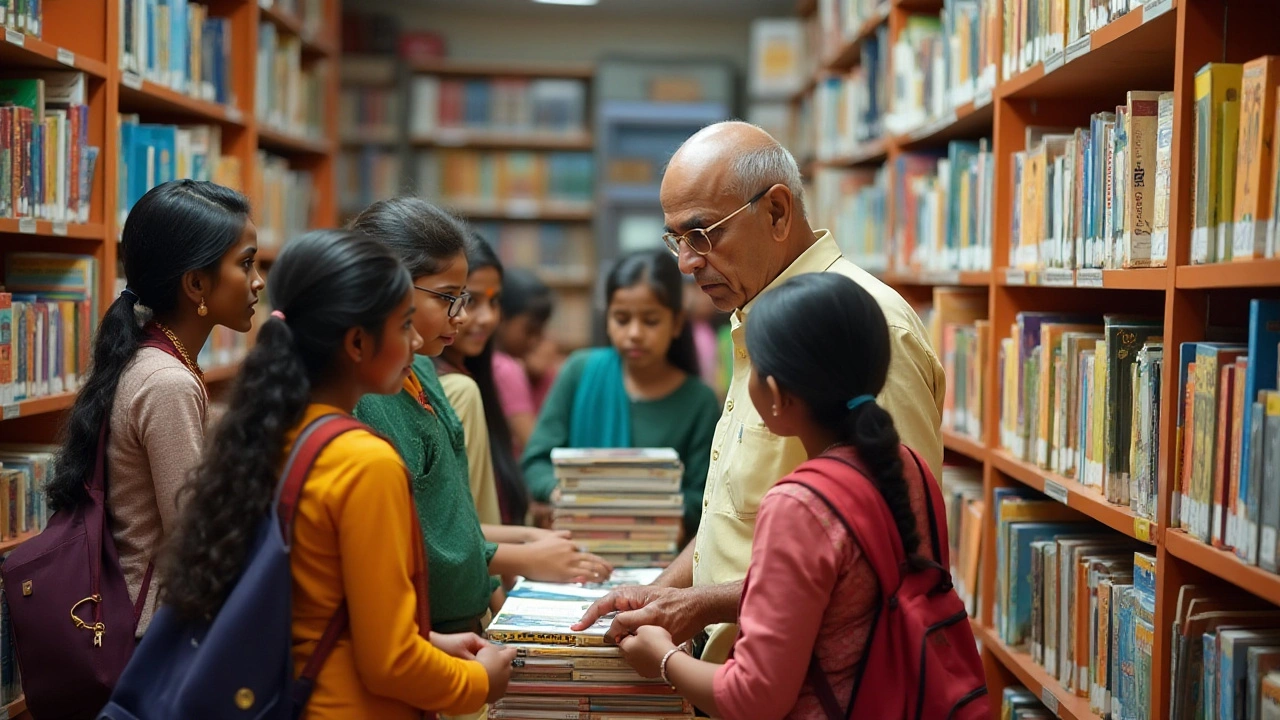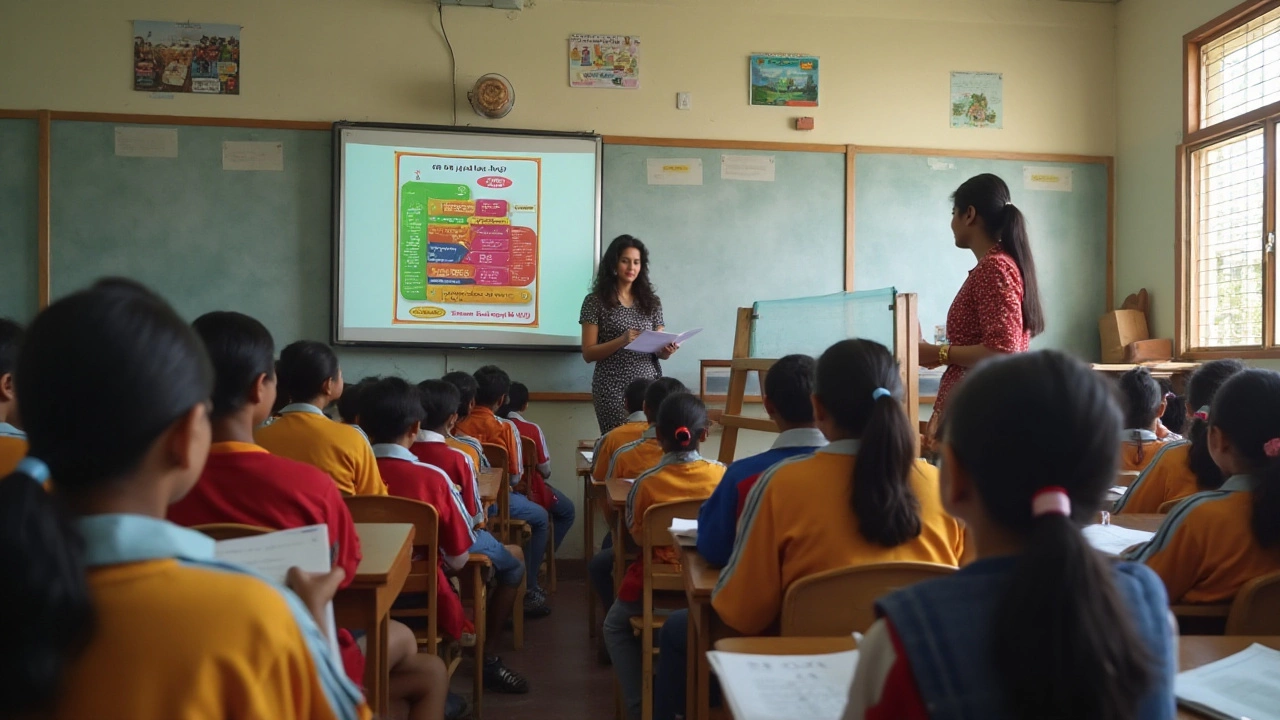Choosing the right educational board for a child is crucial in shaping their academic journey and future prospects. India, known for its vast and diverse educational landscape, offers several options, but among the most preferred is the Central Board of Secondary Education (CBSE). Parents often grapple with questions about which board provides the smoothest path for students, aiming for a balance between rigorous education and manageable workload.
This article breaks down the basics of the CBSE, helping parents and students understand what makes it one of the easiest boards in India. We delve into the syllabus structure, its advantages, and how it stacks up against other popular educational boards. Equipped with these insights, making an informed choice becomes a simpler task. Whether it's the national focus, standardized methodology, or examination style, CBSE has characteristics that align with diverse learner needs.
- Introduction to Education Boards in India
- The Structure of the CBSE Syllabus
- Pros and Cons of CBSE
- CBSE in Comparison with Other Boards
- Tips for Succeeding in CBSE
- Conclusion: Choosing the Right Path
Introduction to Education Boards in India
The educational tapestry of India is as diverse and vibrant as the nation itself. There are several boards that govern school education in India, each offering a unique approach to academics and co-curricular activities. While the country is home to numerous state boards catering to regional languages and needs, there are a few national boards that stand out due to their widespread acceptance and structured curricula. Among these, the CBSE syllabus is prominently recognized, alongside the Council for the Indian School Certificate Examinations (CISCE) and the International Baccalaureate (IB) board.
CBSE, or the Central Board of Secondary Education, is arguably the most popular educational board in the country. It is known for its consistent and standardized syllabus which is prevalent in both rural and urban schools. This board provides a centralized and uniform examination system, ensuring that students from different parts of the country are evaluated on an equal footing. The widespread acceptance of CBSE can be attributed to its affiliation with numerous public and private schools across India, ultimately making it synonymous with higher education readiness.
The Ministry of Education once noted, "CBSE supports continuous and comprehensive evaluation which strives for nurturing all capacities and talents among students." This system aims to reduce the stress of examinations while promoting a holistic educational approach.
Another known entity is the CISCE, which conducts the Indian Certificate of Secondary Education (ICSE) and Indian School Certificate (ISC) examinations. Known for an intensive and detailed syllabus, this board emphasizes a strong command over English language skills and varied subject options. Meanwhile, the IB board, offering an international standard curriculum, is popular among expatriates and those planning for higher education abroad. It focuses on a global context of learning, emphasizing critical thinking, research, and understanding of interconnections between subjects.
Understanding these boards requires a deep dive into their curriculum, examination models, and future opportunities. Parents and students often choose based on long-term educational goals and immediate academic priorities. The choice of board can influence not only the learning experience but also the preparation and eligibility for competitive examinations in India and abroad. With such a rich array of options, India's educational boards cater to the aspirations of a diverse student body, each with its unique needs and ambitions.
The Structure of the CBSE Syllabus
The CBSE syllabus serves as a foundational pillar for students across India, bringing consistency and a standardized educational experience. One of the key aspects that sets it apart is its structure, which is designed to cater not only to grasp knowledge but also to develop core skills and competencies in students. The syllabus is meticulously curated and is periodically updated to align with contemporary educational trends. CBSE emphasizes integrated education that balances academic learning with practical application, which is reflected in its syllabus. Such a structure helps in preparing students for national level competitive exams, a vital aspect for parents aspiring for their children to succeed in fields like engineering and medical sciences.
The syllabus covers a wide range of subjects. For instance, at the primary level, students are introduced to the basics of languages, mathematics, and environmental studies. As they move to the middle school level, subjects like science and social studies are introduced to develop a more comprehensive understanding of the world. The real transformative phase comes in high school, where subjects are divided into different streams such as science, commerce, and humanities. Each stream is equipped with a blend of mandatory and elective subjects, ensuring a well-rounded education. This allows students to gradually identify their areas of interest before stepping into higher education.
A noteworthy feature of the CBSE syllabus is its national benchmarking. The syllabus is structured in a way that facilitates a fair assessment of student performance across the country. This nationwide standardization helps mitigate the bias that might arise due to regional boards. “The CBSE has not only adapted to global educational standards but also has set a benchmark in India for quality education,” says Dr. Anurag Tripathi, Secretary, CBSE. Such insights emphasize why many parents and students prefer CBSE over other boards. Additionally, it helps in the seamless transfer of students across schools in different states, a crucial factor for families with transferable jobs.
The CBSE also emphasizes continuous and comprehensive evaluation, which means that student assessment is not solely dependent on year-end exams. Instead, it includes periodic tests, assignments, projects, and oral assessments throughout the academic year. This approach aids in developing a more robust understanding of the subjects, reducing stress on students, and promoting continuous learning. It also provides teachers with the opportunity to track individual progress effectively and provide timely intervention when required. Such a balanced focus attracts both students and educators towards CBSE, making it synonymous with holistic education.
Innovation in education is another strong suit of the CBSE. The introduction of skill-based subjects and vocational courses encourages students to explore various interests. Courses like Artificial Intelligence, Yoga, and Financial Literacy are now part of the curriculum, catering to modern educational demands. This initiative not only makes learning exciting but also equips students with skills necessary for current and future job markets. The suo moto inclusion of life skills, moral education, and physical development in the syllabus ensures that students are not only prepared academically but are also made ready for life's diverse challenges.
For parents contemplating whether CBSE is the right choice, understanding its syllabus structure helps underscore its capabilities in nurturing well-rounded individuals. The structured flexibility offered by the CBSE syllabus nurtures exploration, harnesses potential, and safeguards academic integrity, assuring that students are not just rote learners but thinkers and innovators prepared for the broader world.

Pros and Cons of CBSE
When evaluating the Central Board of Secondary Education, it's important to weigh both the strengths and potential drawbacks to ensure an informed decision. The **CBSE syllabus** is designed to provide a comprehensive education while maintaining a certain discipline in academics. Its wide acceptance across India and even abroad offers a significant advantage. For students who frequently relocate due to their parents’ jobs, CBSE ensures a seamless educational transition, as its schools are widespread and adapting to a new school feels less disruptive. Moreover, the curriculum is often updated to include new technologies and global educational trends, preparing students for higher education and competitive exams. Particularly, CBSE aligns well with entrance exams like JEE and NEET, making it a favorable choice for students aiming for prestigious Indian institutes like IITs and AIIMS.
Benefits of the CBSE System
One major pro of the **CBSE** system is its structured and student-friendly approach. The curriculum encourages critical thinking, problem-solving, and application-based learning, which are crucial skills in today’s world. This board emphasizes both scholastic and co-scholastic activities, ensuring a holistic growth environment. The question papers are predominantly based on the NCERT books, which are known for their clarity and well-researched content. Students also appreciate CBSE’s consistent focus on lightening loads by reducing unnecessary content and promoting more class interactions. On a lighter note, students benefit from their English being strengthened due to CBSE’s high standard in these subjects.
Challenges Faced in CBSE
However, like any system, CBSE has its share of challenges. Critics often point out that while it is a popular choice, the standardization can sometimes restrict innovative teaching methods that some other boards encourage. The board's focus on theory-based exams can occasionally overshadow practical learning, which some argue is critical to student development. There is also the concern that the emphasis on cracking competitive exams might put undue pressure on students, steering the education system more towards rote learning than understanding. Additionally, heavy reliance on **CBSE schools** for achieving high cut-offs can lead to an unnecessarily competitive environment, sometimes affecting the well-being of students.
“The objective of CBSE is to develop innovative teaching methodologies and at the same time keep the students stress-free, so they enjoy learning,” says Dr. Joseph Emmanuel, Director of Academics at CBSE.
In essence, while the CBSE seeks to balance academic rigor with student comfort, parents and students must individually assess whether its strengths align with their educational goals and preferences. The choice of board significantly impacts a student's educational journey, shaping both knowledge acquisition and personal development.
CBSE in Comparison with Other Boards
Making sense of India's educational boards involves unraveling each board's distinctive attributes. Among them, the CBSE syllabus heralds its way into the lives of many students, celebrated for its structured methodology and national orientation. While the CBSE board is a prominent choice, it's essential to juxtapose it with other significant boards like the ISC, State Boards, and international options like the IB. Understanding these contrasts not only aids parents in making informed decisions but also highlights the merits specific to CBSE.
The CBSE board's popularity chiefly stems from its consistency across the nation. Students benefit from a standardized curriculum, a boon for families who frequently relocate within India, ensuring minimal disruption in academic progress. Notably, when compared with State Boards, which often have regional languages and localized content, CBSE boasts a uniform medium of English as the dominant teaching language. This positioning could decidedly cater to those aiming for national-level entrance examinations, as noted by the board's prelude emphases on entrance preparedness.
Fascinatingly, the CBSE aligns its examinations to nurture critical thinking and problem-solving skills, with a clear focus on Science and Mathematics—subject areas where global prowess is significant. This stands in contrast to the Council for the Indian School Certificate Examinations (CISCE or ISC), known for its intensive syllabus and a more holistic curriculum, extending substantial weight to humanities and arts. A profound critique from educators is that while ISC propels comprehensive academic growth, it might excessively burden students unprepared for rigorous content.
“CBSE undoubtedly sheds light on future-ready skills, but engaging in ISC could expand horizons for students willing to grapple with a challenging curriculum focused on empirical learning.” – Educationalist, Elina Roy
Meanwhile, the International Baccalaureate (IB) proposes a curriculum bent towards international standards, promoting inquiry-based learning and global citizenship. For expatriates or families planning an international trajectory, IB shines brightly. However, the CBSE's competitive edge lies in its integration with Indian competitive exams, laying a foundation that complements examinations like JEE and NEET extensively. Affordability is another aspect where CBSE often tops lists, providing quality education at costs accessible to a broader demographic.
Comprehensive data suggests an uptick in CBSE enrolments, attributed to its flexible structure, which adapts to diverse educational systems globally. As illustrated in recent surveys:
| Board | Primary Language | Enrolments (%) |
|---|---|---|
| CBSE | English | 55 |
| ISC | English | 30 |
| State Boards | Local Language | 15 |
The decision boils down to identifying long-term goals and academic preferences. With CBSE's balanced delineation of theory and application, students migrating frequently or planning future studies in Indian technical institutions often recognize it as the most supportive board. Whether it's its simplicity in moving locations or its stead in competitive exam landscapes, the CBSE board echoes an adaptability unmatched by its counterparts, offering a nimble path for learners of various backgrounds.

Tips for Succeeding in CBSE
Success in the CBSE syllabus doesn't happen overnight. It requires a blend of dedication, effective study habits, and a clear understanding of the curriculum. The CBSE board is known for its comprehensive approach, which means students benefit from organizing their study schedule early on. Begin by familiarizing yourself with the academic calendar, exam schedules, and syllabus outlines provided at the start of the year. This foundation will empower you to plan your study sessions around key dates, avoiding last-minute cramming and stress.
One effective strategy is adopting the Pomodoro Technique, which revolves around breaking down work into intervals, traditionally 25 minutes in length, separated by short breaks. This not only enhances focus and retention but also prevents burnout, a common obstacle faced by students tackling the extensive CBSE curriculum. Consistent revision is another cornerstone of success; preparing brief, concise notes summarizing each chapter can significantly aid this process. Moreover, students often find it beneficial to form study groups, facilitating peer-learning which can deepen understanding as they exchange perspectives and solutions to challenging problems.
Achieving high scores often hinges on performing well in both theoretical and practical components. CBSE prioritizes both, so engaging actively during lab sessions and taking thorough notes can have a substantial impact. It's vital to understand that CBSE's assessment isn’t limited to rote memorization. Instead, focus on conceptual clarity and application skills. Using past year papers and sample papers to practice is an invaluable tool for getting comfortable with the format. According to a study conducted by the National Achievement Survey, students who actively engage with past papers see a marked improvement in their scores.
"Education is not the learning of facts, but the training of the mind to think," — Albert Einstein. This resonates well with the essence of CBSE's approach, which encourages students to develop a holistic thought process.
Balancing work and relaxation is crucial. Incorporating extracurricular activities or hobbies into daily routines can significantly boost mental health, thereby enhancing academic performance. Educational psychologists suggest that activities like music, sports, or art can enhance cognitive abilities and boost overall well-being. Lastly, maintaining open communication with teachers can be immensely beneficial. They can provide guidance on difficult topics, offer extra resources, and assist with doubts outside classroom hours, which is particularly helpful for tackling challenging sections of the Indian education board.
Conclusion: Choosing the Right Path
Deciding on the right educational board for one's child is akin to paving the smoothest route on a new journey. While each student has unique strengths and learning preferences, the decision must often weigh the benefits against potential challenges. The Central Board of Secondary Education, known widely across the nation, presents a structured syllabus that aligns well with India's national education goals. Renowned for its comprehensive nature, the CBSE syllabus encompasses a broad spectrum of subjects, encouraging a harmonic blend of academic rigor and practical application.
The increasing popularity of CBSE could be attributed to its uniformity across schools, making transitions seamless for families that relocate frequently. The board's emphasis on science and mathematics has been well-received by students preparing for competitive exams and seeking future endeavors in these fields. Parents see added value in CBSE due to its systematic approach to assessment, characterized by evaluations that encourage analytical and critical thinking over rote memorization. According to National Institute of Open Schooling, "CBSE continues to evolve, integrating newer educational methodologies and technology to benefit from innovative learning paths."
In contrast to many regional boards, CBSE remains highly regarded on a global scale. Graduates of CBSE are appreciated in international universities, further legitimizing the board's standing. While some may argue that CBSE's emphasis on theoretical knowledge can overshadow creative pursuits, the board's constant revisions aim to adapt to modern education's dynamic nature. Families must consider the student's personal aspirations, current aptitude, and preferred learning style to make an informed choice. After all, the most suitable educational path is the one that nurtures growth, interest, and curiosity, leading students toward a bright and successful future.
Equipped with this understanding, selecting the right board for one's child is a step taken with clarity and confidence. The journey of education isn't just about shedding light on facts; it's about enlightening students with the marvels of learning. As parents and educators navigate this landscape, it becomes evident that every decision made today will echo in the futures constructed for tomorrow.
